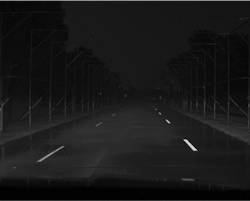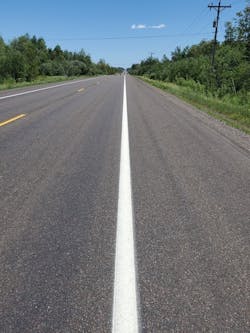Setting a wet reflective pavement marking specification
Highly visible, consistent pavement markings providing the guidance drivers need to stay on the road and in their lanes are a critical piece of infrastructure on any safe road system. However, for pavement markings to serve their purpose, drivers need to be able to see them in a wide range of conditions—day or night, rain or shine.
Over the years, crash data and studies have shown that driving at night in the rain is difficult for drivers. These challenging road conditions often increase the likelihood of crashes. In 2018 alone, 2,884 people died on U.S. roads when it was raining. Of those fatal crashes, 59% occurred at night or in low-light conditions, even though only 25% of travel happens at night.
A significant factor contributing to these crashes is the fact that when it is raining in low-light conditions, standard pavement markings can become virtually invisible to drivers.
The science behind pavement marking visibility can help us understand why. Typically, pavement markings are embedded with retroreflective glass beads (optics) that reflect light from a vehicle’s headlights back to the driver. The most common types of pavement markings use retroreflective optics with a refractive index (RI) of 1.5—an economical optic that is sufficient for dry conditions. In rainy, wet conditions, these optics become surrounded by water. Water has a higher RI than air and tends to spread the reflected light from a vehicle’s headlights out in a much broader, weaker cone. As a result, the pavement marking becomes very difficult to see.
Wet reflective pavement markings are engineered to counteract the effects of water and can significantly improve road safety. Made with a mix of 1.9 RI optics (optimized for visibility in dry conditions) and 2.4 RI optics (optimized for visibility in wet nighttime conditions), wet reflective pavement markings provide the consistent visibility drivers need to see their lanes and stay on the road in a range of conditions. This is why it is so important for state DOTs, local agencies, and road planners to establish a wet reflective pavement marking specification in their jurisdiction. Wet reflectivity standards were recently discussed during a recent presentation called "Setting a Wet Reflective Pavement Marking Specification" from 3M Global Marketing Manager Andrew Goodrich, MnDOT Traffic Engineer Ethan Peterson, and St. Louis County Traffic Engineer Victor Lund.
MnDOT Studies Human Factors to Establish a Wet Reflective Visibility Standard
The road planners and safety experts at the Minnesota Department of Transportation (MnDOT) know the safety benefits of highly visible pavement markings. One of the group’s primary goals is to provide an “appropriate pavement marking that meets or exceeds the standards defined in the MN MUTCD on all highways throughout the state, 365 days a year.” MnDOT traffic engineer Ethan Peterson and his colleagues also recognize the importance, and the challenge, of providing visible pavement marking guidance in the wide range of conditions drivers face on Minnesota roads.
To help them understand the visibility levels drivers need in wet, nighttime conditions and establish a wet reflective visibility standard in the state, MnDOT funded a study completed by Texas A&M Transportation Institute to observe human factors impacting pavement marking visibility. They based the study on a 60-year-old driver with 20/25 vision traveling at 60 mph at night in 1.5 in./hour rain (a heavy rain), and requiring a minimum of 1.8 seconds of preview time in order to safely maintain lane positioning. They then collected a representative participant group and had them first observe pavement markings under wet conditions in a rain tunnel, and then observe pavement markings under dry conditions.
Based on their findings, the MnDOT research team determined that pavement markings need to provide an in-service minimum continuous wet retroreflectivity level of 50 mcd/m2/lux to allow the minimum preview time at 60 mph in wet conditions. From this standard, they back-calculated the wet retroreflectivity level over four years to recommend an initial minimum continuous wet retroreflectivity level of 200 mcd/m2/lux. The MnDOT team believes that by installing pavement markings that meet these wet reflective standards, they can significantly improve road safety throughout Minnesota.
The Importance of Highly Visible Pavement Markings on County Roads
Roadway departure crashes continue to represent the largest share of serious crashes on our nation’s roads. According to traffic engineer Victor Lund, the issue is particularly pronounced on the county road system. For example, in St. Louis County, Minnesota, where Lund works, roadway departure crashes account for 54% of all serious crashes on county roads. In Minnesota, county roads are a significant contributor to the overall rates of serious crashes. In 2019, there were 364 traffic fatalities on all roads in Minnesota. Of these traffic fatalities, 47% occurred on the state trunk highway system and 39% of fatalities due to crashes occurred on the county road system.
The crash data supports the need for significant investments in traffic safety strategies on county roads. However, the county road system in Minnesota is vast and the challenge becomes deciding what to prioritize and where to invest limited budgets. In Minnesota, the fatal crash density on county roads is approximately 0.003 fatal crashes per mile per year. That means on average, for any randomly selected 1-mile county road segment, more than 300 years would need to pass before the next fatality would likely occur on that stretch of road. In other words, it is difficult to predict where the next serious crash will occur on rural county roads. For a traffic safety strategy to effectively reduce the number of serious crashes on county roads, it is best to implement that strategy proactively based upon a systemic approach.
To address this challenge, Lund and his colleagues in St. Louis County are widely deploying and maintaining consistent, visible road markings throughout their system—especially wet reflective pavement markings and 6-in.-wide edgeline markings. These pavement markings are a low-cost strategy that has been demonstrated to help drivers stay in their lanes and reduce the number of roadway departure crashes in their county. St. Louis County has realized this effort is essential in helping to drive Minnesota Towards Zero Deaths.
Taking the Next Step Towards Setting a Wet Reflective Pavement Marking Specification
To build safer roads and provide the guidance that drivers need at night and in the rain, it is critical to deploy wet reflective pavement markings that are visible in those conditions. If you are interested in setting a wet reflective pavement marking specification in your own state, county, or jurisdiction, you can get started by evaluating your road system, crash rates, weather patterns, and the demographics of your drivers. With this information you can pinpoint problem areas and plan strategies that will make the biggest impact on road safety. It can also be helpful to look at studies performed by other agencies, including the human factor study put together by MnDOT, to understand the requirements of a wet reflective pavement marking standard.



